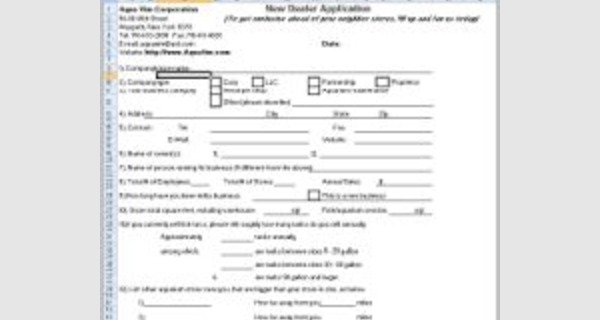Excel template for aquarium maintenance

Excel template for aquarium maintenance
This article provides details of Excel template for aquarium maintenance that you can download now.
Maintaining an aquarium requires a lot of physical and technical knowledge, which is why you cannot improvise in the aquarium hobby.
Microsoft Excel software under a Windows environment is required to use this template
These Excel templates for aquarium maintenance work on all versions of Excel since 2007.
Examples of a ready-to-use spreadsheet: Download this table in Excel (.xls) format, and complete it with your specific information.
To be able to use these models correctly, you must first activate the macros at startup.
The file to download presents three Excel templates for aquarium maintenance
... ...
An aquarium is a miniature form of an ecosystem which adds to the beauty of our home. This natural “living jewels” makes our living room more attractive and reduce the tensions experienced by the family members or the visitors. The major advantage of aquarium keeping is the low expenditure incurred when compared to other pets.
History of keeping aquarium fishes as pets
The idea of aquarium fish keeping is as old as recorded in history. The Sumerians, Assarians and Egyptians have all kept fish in ponds. By the end of the 17th century gold fish was introduced in several countries and became popular in England and Scotland. The opening of the fish house in London Regent Park during the spring of 1853 is the world’s first aquarium.
Fabrication of aquarium tank and accessories
Considering the safety and reliability of aquarium tank you should remember the following factors.
- Aesthetic beauty
- Size and shape of the tank
- The volume of water
Additional care- There is no additional cross belt in the upper portion of the tank up to a size of 3x1x2. The tanks above 3x1x2 size and up to 4x2x2’ size requires additional cross belt on the upper side. Above 4x2x2’ size needs beading and cross link with a size of two inch. Recently, imported modular tanks of various sizes are available in the market.
Fabrication of the tank
Fabrication of aquarium tank is an art which we can learn within two to three days of practical experience. The good quality glass, gum, glass cutter and silicone sealant can be purchased from glass merchants. When taking measurement for cutting the glass or giving order you should take care about the side glass (width wise glass). Regarding the width; deduct two times thickness of selected glass from the width of base glass.
Place the base glass on a leveled floor after pasting sealant near to the edges for fixing the other side glass. Then paste sealant along two sides of lengthy glass and fix above the base glass. Later paste sealant on one edge of side glasses and fix it in the corner of lengthy glass. Finally attach the lengthy glass to the previous one. After finishing the mould, firmly tie a sting covering four sides of the tank for avoid sliding the glass while pasting sealant in the corners.
Height of the tank- The aquarium tank should always be kept at height of 2.5 feet for viewing from standing and sitting positions in a living room. Hood and lighting- The tank is covered with beautiful roofs made up of plywood or any other wood. The roof is provided with feeding facility and the facility to attach suitable lighting. The tank must be placed not far away from the window,(but not close to the window) which helps to allow some natural light into the aquarium and to promote the growth of plants inside the tank. Keeping the tank near to the window invite excess algal growth, which will destroy the beauty of the tank. For easy operation and safety providing electrical plug points near to the tank is ideal.
Advance preparation for tank setting- Necessary drift wood, river sand and rocks should be thoroughly washed under running water till water turns clear. Some quantity of gravel and river sand(raw) mixed with vermicompost is better for growth of the plants. This mixture should be spread just below the washed river sand. Landscaping is to be decided well in advance,we can use silicone sealant for making desired shape in wood or in rock.
Setting of aquarium- Place the aquarium tank on an even surface(use water level hose or spirit level gadget) preferably on one inch thickness Thermocol sheet. After placing tank carefully insert under water gravel filter plate into the tank along with air lift pump. Then spread one to two cm manured mixture above the filter, above the mixture spread through washed river sand slopping towards front side. Modulated rocks and drift woods are firmly fixed in the land scape position. Air stones can be placed behind rocks for good visual effect. Decorate with aquarium plants depending upon your imagination. Fast growing plant and tall plants like vallisneria, cobomba, sagittaria are ideal for background planting. Bushy plants should be used to fill the corners and plants like ludwigia,amazon sword, small mint, water fern can be used in front portion. While planting the long rooted species, assure that the roots are not damaged. Bushy plants should be tied with a stone to fix them in position. Before planting, the plants must be thoroughly washed in running water to remove any unwanted snail ,eggs and larvae attached with this plants. Dip the washed plants in 0.1% KMno4 (Potassium permanganate)solution one to five minute and again wash in running water. Once the planting is over, the aquarium tank is filled with water without tilting the plants and other settings. Then cover the tank with the lighted hood.
Tank conditioning- Air pump and other electrical fittings (power head, filter, heater etc) are switched on and allow to run continuously for three to five days. During this time water will be cleared and the plants roots will take their position. Flow rate should be adjusted to 18 to 20 times per day for proper functioning of biofilter and the consequent removal of ammonia with the help of nitrifies.
Introducing the fishes- When purchasing fishes it is essential to make sure that they come from reliable source and are free from disease. Keep the bags containing fishes in the aquarium tank for an hour to acclimatize. After half an hour gradually acclimatize the fish by adding tank water into the fish bag for better survival of fish in the tanks. Stocking density can be adjusted as) 75 cm2 space for a 2.5 cm fish. As a thump rule-Total surface area (Length x Breadth) of the tank divided by (3x2+6x+3)/2, where ‘x’ is size of the fish.
Water quality parameters
The key to a successful, healthy aquarium is in maintaining good water quality for the creatures in your care. Most fish health problems are caused by poor water quality and many factors can cause this including type and frequency of the maintenance you carry out, inadequate filtration, stocking levels, overfeeding, and so on. The most important water quality parameters for a tropical community aquarium, or goldfish aquarium are as follows:
Ammonia - excreted by fish into the water; ammonia is poisonous and must be removed. If the filter is working properly, there should be no ammonia in the water. It is recommended to test for ammonia every week.
Nitrite - bacteria in the filter turn ammonia into nitrite, which is also poisonous. If the filter is working properly, this is also removed, and there should be no nitrite in the water. It is recommended to test for nitrite every week.
Nitrate - bacteria in the filter turn nitrite into nitrate, which is harmless to most fish. It is however an algae nutrient, and should be controlled if it gets very high. It is worth testing the nitrate level if you have a
problem with algae in the aquarium or pond. Very low nitrate levels are only important for sensitive freshwater fish and marine aquariums.
pH - a measure of the water’s acidity. Fish do not respond well to rapidly changing pH levels, and therefore a stable value is important. Pond fish, goldfish, and hardy tropical fish require a stable pH between 6.5 – 8.5.
Sensitive tropical fish and marine fish have more particular pH requirements.
Oxygen - like all animals, fish require a plentiful supply of oxygen. Because water contains much less oxygen that air, it is important to provide some form of aeration in an aquarium.. Extra aeration can also be provided with aerators, air-pumps,.
